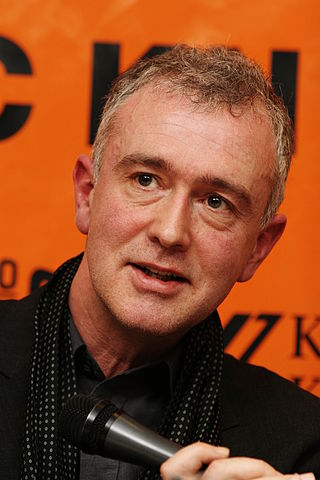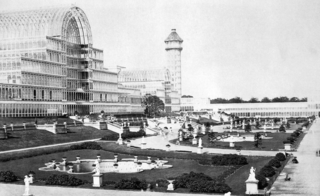Related Research Articles

Patrick MacDowell was a Belfast-born British sculptor operating through the 19th century.

John Atkinson, Baron Atkinson, was an Irish politician and judge. He was a Lord of Appeal in Ordinary from 1905 to 1928.

Joseph Victor O'Connor is an Irish novelist. His 2002 historical novel Star of the Sea was an international number one bestseller. Before success as an author, he was a journalist with the Sunday Tribune newspaper and Esquire magazine. He is a regular contributor to Raidió Teilifís Éireann (RTÉ) and a member of the Irish artists' association Aosdána.

Thomas Langlois Lefroy was an Irish-Huguenot politician and judge. He served as an MP for the constituency of Dublin University in 1830–1841, Privy Councillor of Ireland in 1835–1869 and Lord Chief Justice of Ireland in 1852–1866.

Anne Elizabeth "Elsie" Fogerty was a British teacher who departed from the customary practice of "voice and diction" also called elocution. At that time "Voice and Diction" focused entirely on the mouth and nasal cavity to produce speech sounds. Fogerty's technique ended up focusing on the entire body and voice to produce speech. At first, she used just the lungs to resonate the sound, but soon included the whole body, because she discovered that posture and movement also affected speech. It ultimately became known as the "Body and Voice" technique. She was founder and principal of the Central School of Speech and Drama in London from 1906 to 1942.
Events from the year 1844 in Ireland.
Sir Charles Fox was an English civil engineer and contractor. His work focused on railways, railway stations and bridges.
James Pain was an English architect. Born into a family of English architects, his grandfather was William Pain, his father James Pain and his brother George Richard Pain. James Pain served as an apprentice to the architect John Nash of London. James and George Richard were commissioned by the Board of First Fruits to design churches and glebe houses in Ireland. In 1833, James Pain became one of the four principal architects of the Board of Ecclesiastical Commissioners. He settled in Limerick, Ireland. Many of his designs were produced in collaboration with his brother George Richard who practised in Cork.

Colonel Thomas de Burgh, always named in his lifetime as Thomas Burgh, was an Anglo-Irish military engineer, architect, and Member of the Parliament of Ireland who served as Surveyor General of Ireland (1700–1730) and designed a number of the large public buildings of Dublin including the old Custom House (1704–6), Trinity College Library (1712–33), Dr Steevens' Hospital (1719), the Linen Hall (1722), and the Royal Barracks.
William Fogerty, FRIAI, FRIBA, AAI was an Irish architect active in mid-nineteenth-century Limerick, London, New York City and Dublin.

John Fogerty was an Irish millwright, architect, builder, and civil engineer, active in early to mid-19th-century Limerick.He was the brother of Joseph Fogerty Sr. and the father of engineer and novelist Joseph Fogerty of London, architect William Fogerty of Dublin, and grandfather of architect John Frederick Fogerty. He retired as an architect sometime between 1870 and 1879.
John Frederick Fogerty (1863–1938), was an Irish architect and engineer active late 19th-century Limerick, London, Shropshire, Bournemouth, Pretoria, and Zambia. Born in Limerick, he was the son of architect William Fogerty, grandson of architect and engineer John Fogerty (engineer), and nephew of engineer and novelist Joseph Fogerty. He earned a bachelor's degree in engineering from Queen's College, Cork in 1883, and attended the South Kensington Art School the year later. He was articled to Sir Thomas Drew. In 1889, he established his office at Wellington, Shropshire, and entered into partnership with Reginald George Pinder in Bournemouth in 1893, later amalgamating Pearce & Parnell of Bournemouth in 1902. He emigrated to South Africa in 1914 and enlisted at the outbreak of the First World War, serving time in South Africa, the Isle of Wight, Palestine, and Poona, India. During the interwar period, he worked as an engineer in Pretoria's Public Works Department, before becoming borough surveyor in Lusaka, Zambia, in 1926, where he died in 1938.
Joseph Fogerty Sr. was an Irish builder and architect active in nineteenth-century Limerick. Born in Limerick into a family of builders, he was the father of Robert Fogerty and George J. Fogerty; brother of John Fogerty (engineer), uncle of engineer and novelist Joseph Fogerty of London and architect William Fogerty of Dublin, and great uncle of architect John Frederick Fogerty. He designed and built the Theatre Royal, Limerick, Henry Street. From the 1870s until his death, he was partners with his son Robert in the firm Joseph Fogerty & Son.
Joseph Fogerty & Son was an Irish architectural firm active from the 1870s until 1887 in Limerick and throughout the west of Ireland. It was composed of Joseph Fogerty Sr. and his son Robert Fogerty.

Crystal Palace School of Art, Science, and Literature, also known as Crystal Palace Company's School of Art, was opened in 1854 by the Crystal Palace Company as a new enterprise, to occupy part of the centrepiece building of the Great Exhibition, following its re-erection in suburban south-east London.

Sir Richard Percivale of Sydenham, near Bridgwater, Somerset, was an English administrator and politician, also known as a Hispanist and lexicographer. He wrote a Spanish grammar for English readers, A Spanish Grammar, and a dictionary, both included in his Bibliotheca Hispanica (1591); this work was later enlarged by John Minsheu in A dictionarie in Spanish and English.
Thomas Philip Le Fanu (1784–1845) was an Irish Dean in the first half of the 19th century. He was the son of Joseph Le Fanu and Alicia Sheridan, and the father of Joseph Sheridan Le Fanu and William Richard Le Fanu. He married Emma Lucretia Dobbin.
Sancton Wood was an English architect and surveyor, known for his work on railway buildings.

Combe is a historic estate in Somerset, England, situated between the town of Dulverton and the village of Brushford.
John Russell Gubbins was an Irish racehorse owner and breeder.